Should You Clean a Coffee Maker Before First Use
Cleaning your coffee maker before its first use is essential for hygiene and machine performance. It removes manufacturing residues, bacteria, and dust. Begin by washing removable parts with warm, soapy water and descaling the machine using an appropriate solution. This prevents buildup, ensuring your coffee's taste and your health's safety. A clean machine not only brews better-tasting coffee but also extends its lifespan. Ready to make the most of your coffee maker and enjoy great coffee?
Key Takeaways
- Cleaning before first use removes manufacturing residues and dust, ensuring hygienic coffee preparation.
- Pre-use cleaning prevents bacterial and mold growth by eliminating damp storage contaminants.
- Initial cleaning improves coffee maker performance by preventing residue buildup.
- Proper cleaning extends the machine's lifespan by reducing mineral deposits and wear.
- Cleaning safeguards against potential health risks from contaminated coffee consumption.
Understanding the Importance of Pre-Use Cleaning
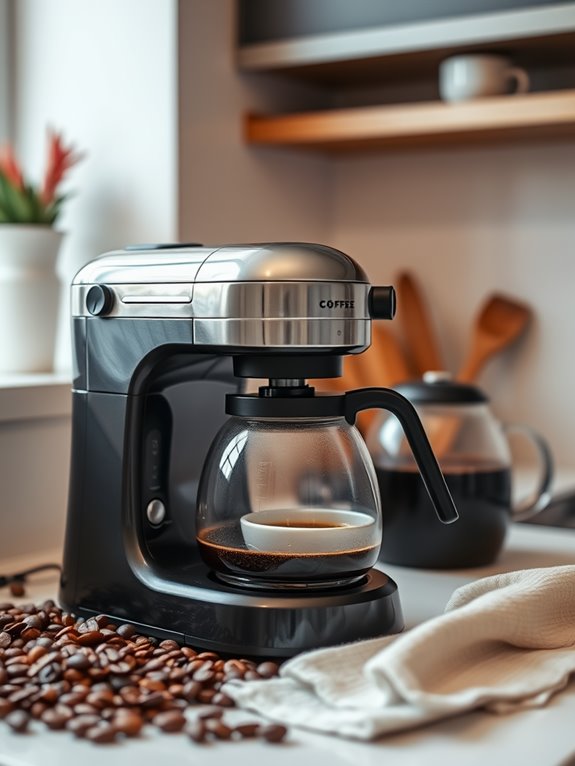
Before you brew your first cup of coffee in a new machine, it's vital to understand why cleaning it beforehand matters.
Let's investigate the reasons:
First, pre-use cleaning prevents residue and buildup, removing manufacturing chemicals or dust that could affect taste.
Ensuring hygiene is important, as it prevents bacterial or mold contamination from the start.
This step also improves performance by keeping the machine free of obstructive substances.
Regular weekly maintenance of removable parts like the filter basket helps prevent bitter coffee taste.
By protecting your health, you reduce the risk of consuming contaminated coffee.
Finally, cleaning extends machine life, minimizing early wear due to mineral buildup and ensuring consistent brewing quality. Regular cleaning maintains optimal performance and coffee quality.
Recommended Cleaning Methods for New Coffee Makers
When it comes to preparing your new coffee maker for its debut brew, several recommended cleaning methods can guarantee a fresh start.
Let's examine them.
Cleaning with Vinegar: Mix equal parts vinegar and water, run half through, pause, then continue.
Remember to rinse with fresh water to avoid any lingering taste.
Specialized Cleaning Products: Use cleaning tablets like Urnex Cleancaf to remove oils and residues.
Follow with fresh water cycles.
Descaling Methods: Dissolve a descaling agent in warm water, run a cycle, and rinse thoroughly.
Regular maintenance, including washing removable parts and cleaning the brew nozzle, guarantees your machine stays efficient.
For optimal performance, implement a regular cleaning schedule every 3-6 months using these methods.
Step-by-Step Guide to Pre-Use Cleaning
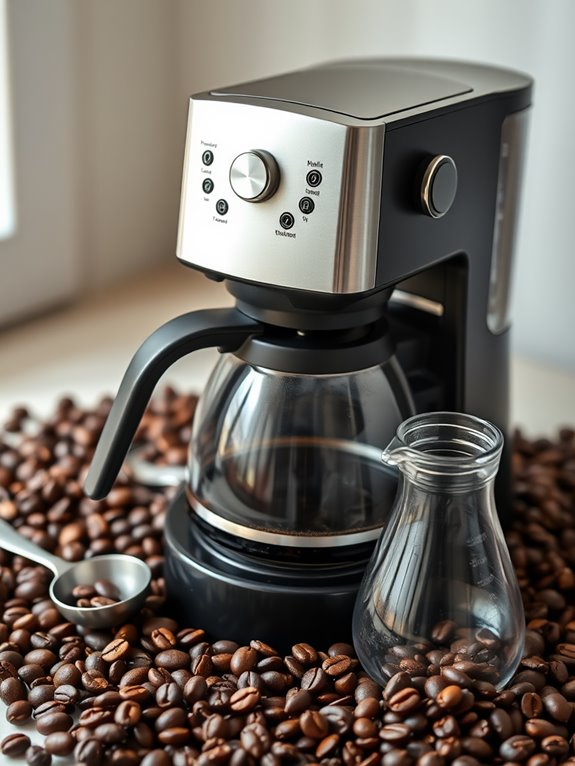
To guarantee your new coffee maker delivers the best flavor right from the start, it's essential to follow a detailed pre-use cleaning routine.
Let's investigate the crucial steps: First, remove all packaging materials, confirming nothing's left inside.
Wash removable parts with warm, soapy water, and dry them thoroughly to avoid water spots.
Next, wipe the machine's exterior with a damp cloth.
If the manufacturer recommends, descale the machine using their guidelines.
Remember, always consult the manual and avoid abrasive cleaners.
Use a soft cloth for non-removable parts and verify everything's dry before reassembly.
These steps confirm peak performance and taste.
Before plugging in your machine, check that your power outlet works properly by testing it with another appliance.
Avoiding Common Mistakes in Cleaning
Cleaning your coffee maker might seem straightforward, but common mistakes can compromise its performance.
Let's investigate how to avoid them. First, always flush the group head and wipe the portafilter immediately to prevent stubborn residue.
Clean the steam wand often or risk milk buildup. Never use abrasive materials; they can scratch your machine.
For coffee capsule machines, avoid vinegar for descaling, as it leaves odors and doesn't efficiently remove limescale—choose a proper solution instead.
Remember to clean the capsule basket and drip tray regularly.
Finally, follow the manufacturer's instructions and rinse thoroughly to guarantee no lingering tastes or odors.
Regular descaling with citric acid helps prevent mineral deposits that can affect your coffee's taste and machine performance.
Health Benefits of Cleaning Before First Use
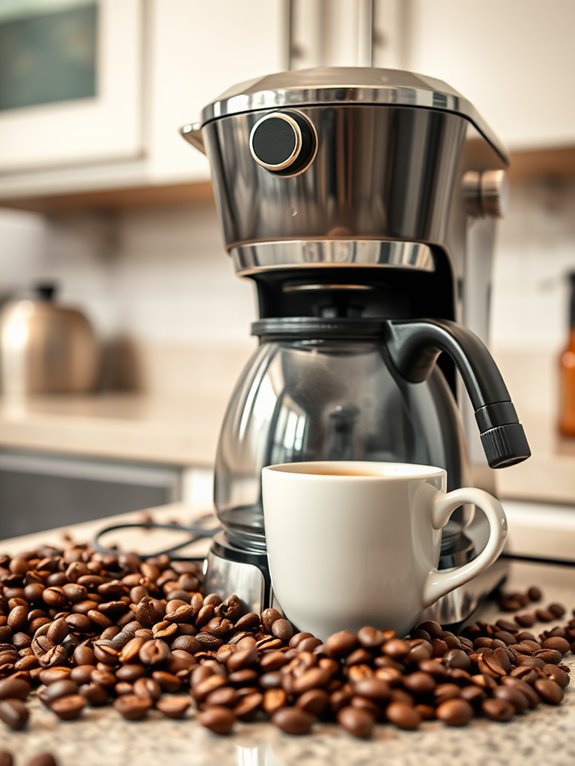
Even though it might seem unnecessary, cleaning your coffee maker before its first use offers significant health benefits.
Bacteria, like Pseudomonas and Enterococcus, can linger in the machine due to moisture, potentially causing infections, especially if your immune system's weak.
Mold and yeast also thrive in damp conditions, making initial cleaning essential.
Manufacturing residues might be present, and cleaning guarantees these don't contaminate your coffee.
Letting germs spread by not cleaning is like ignoring basic kitchen hygiene.
So, wash away any built-up bacteria or mold from storage or transport.
Let's investigate how this simple step safeguards your health.
Enhancing Coffee Taste With Proper Cleaning
When you properly clean your coffee maker, you're not just maintaining its appearance but also enhancing the taste of every cup you brew.
Scale buildup, caused by hard water, can make coffee taste bitter by altering the pH balance and interfering with the brewing process. Regular cleaning and descaling help remove these mineral deposits, preventing chemical tastes and ensuring consistent flavor.
Use filtered water to minimize buildup, and rely on descaling solutions to maintain flavor consistency. Run vinegar or baking soda through your machine, and rinse thoroughly to avoid residue.
Let's investigate how these methods preserve your coffee's delicious taste.
Extending the Lifespan of Your Coffee Maker
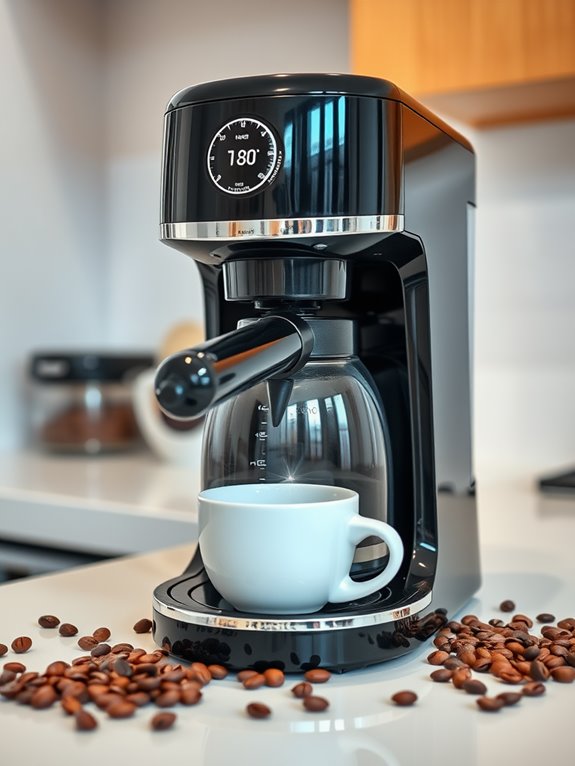
To guarantee your coffee always tastes its best, it's important to focus on extending the lifespan of your coffee maker.
Regular cleaning plays an essential role. Clean removable parts like the carafe and filter basket with soap and warm water.
Descale the machine every few months using a vinegar solution to prevent mineral buildup.
Inspect power cords for damage, replacing them when necessary.
Use filtered water to reduce mineral deposits and store your machine in a cool, dry place.
These practices assure your coffee maker remains efficient, preserving its typical lifespan of 7 to 15 years, depending on usage and care.
Tips for Maintaining Coffee Maker Efficiency
Maintaining your coffee maker's efficiency is essential for delicious brews and a machine that stands the test of time.
Start by emptying and rinsing the drip tray daily to avoid mold and odors. Dispose of used grounds after each use, preventing bacterial buildup. Wipe the exterior with a damp cloth, and clean the portafilter and filter basket with warm water to deter oil accumulation.
Weekly, wash the water reservoir and soak the steam wand to remove buildup. Also, backflush to clear coffee oils.
Regularly inspect for clogged nozzles, and replace water filters to maintain peak performance.
Let's investigate these tips!
Regular Maintenance and Descaling Advice
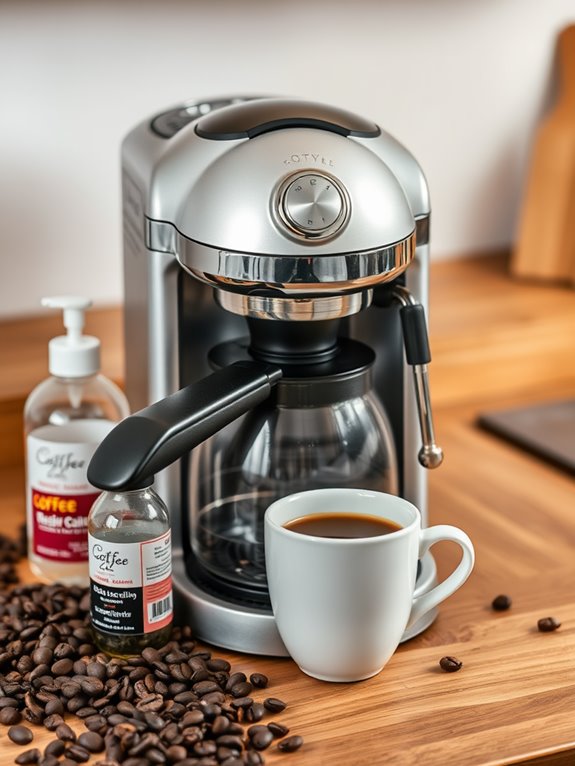
Even though your coffee maker might seem ready to go straight out of the box, regular maintenance and descaling are essential for its ideal performance.
Let's investigate these steps:
Exterior Cleaning: Wipe with a damp cloth, clean the showerhead daily, and never submerge it in water.
Interior Cleaning: Hand-wash parts in warm, soapy water, and consider dishwasher-safe options.
Descaling: Use a commercial descaling agent or white vinegar, followed by fresh water cycles to clear residues.
Frequency: Descale every 1-3 months, adjusting for water hardness.
Regular cleaning keeps your coffee tasting great and prevents bacterial growth.







